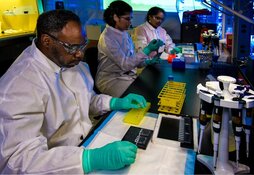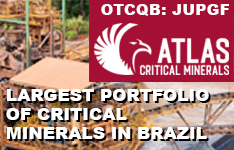TLSR: How are you transforming Nutra Pharma Corp. (NPHC:OTCMKTS) from a company known for making over-the-counter (OTC) pain medications into one that develops therapeutics for pain, HIV and autoimmune diseases?
Rik Deitsch: When I took over this company in early 2003, we were working on a multiple sclerosis (MS) drug, an HIV drug and on autoimmune diseases across the board. We started speaking with the FDA in 2009 about an ethical pain therapy that uses microgram doses of cobra venom extract as a neurotoxin, or neuro blocker, for pain and inflammation. We planned to develop oral, topical and injectable versions of this therapy.
The FDA told us our drug qualified as an OTC homeopathic medication because it is derived from a natural product and because the dosage is so small. That allowed us to create our first OTC drugs in 2009–2010.
"We're trying to build the OTC marketplace to fund clinical work on our drug pipeline."
Now we have seven SKUs (stock keeping units) of Nyloxin, which is our OTC pain treatment for humans, and one SKU of Pet Pain-Away for dogs and cats. We're trying to build the OTC marketplace to fund clinical work on our drug pipeline.
TLSR: Tell us about Nutra Pharma's subsidiary.
RD: ReceptoPharm is a wholly owned subsidiary that holds all of the intellectual property for our drug pipeline. Nyloxin and Pet Pain-Away, however, are held by Nutra Pharma.
TLSR: What does Nutra Pharma bring to the table scientifically?
RD: We have platforms for extracting neurotoxins from cobra venom and making them nontoxic and therapeutic. We can synthesize the peptides or make them through fermentation. The platform is unique.
That's the core of our intellectual property. We have 21 patents, but three are key: one for autoimmune disease, one for pain, and one for antiviral therapeutics. These patents protect different ways of modifying biologics, or modifying native cobra venom.
Normally, there is one drug for any given autoimmune disease. In contrast, we have a drug that modulates the body's immune response. Theoretically, therefore, the drug could work in any autoimmune disease. We've been working principally in MS, but we've also looked at myasthenia gravis, rheumatoid arthritis, Hashimoto's thyroiditis and type 1 diabetes. We believe we can prove our drug would be incredibly effective in all these diseases.
"We have a drug that modulates the body's immune response. Theoretically, therefore, the drug could work in any autoimmune disease."
The drugs that normally treat autoimmune disease shut off the immune system, so the side effects are horrendous. The package inserts for drugs like Humira (adalimumab) or Enbrel (etanercept) advise patients to be checked for all sorts of diseases or infections before using the drug, and advise that patients can be at greater risk for those infections, as well as cancer and death, while taking the drugs. Because we're immunomodulatory, not immunosuppressive, we don't have any of those issues. It's a unique proposition.
Additionally, we've been responsible. As a biotech company working on potential blockbuster drugs, we launched an OTC division that's generating revenue and starting to pay the bills. We've taken a lot of risk out of the equation for our shareholders.
TLSR: You mentioned that the cobra venom compound lacked toxicity, which eliminates the risks of overdose and side effects. Are there any other benefits that investors should know about?
RD: The OTC pain relievers are nonaddictive, nonnarcotic and noninteractive. They lack all the side effects associated with other OTC pain medications. In our last clinical study, we showed that Nyloxin was more potent than morphine. It lasted four hours longer and was 600 times more potent than morphine on a molecular basis. That allows a significantly smaller dose. This is a huge advantage.
The prescription drugs we're working on also generate great benefits without the side effects usually associated with autoimmune and viral disease treatments. Additionally, because we modify these peptides and clinically denature them, they're shelf-stable. They don't require any special handling or expensive refrigeration, which normally is needed for peptide products or biologics. Therefore, it becomes much more cost-effective to produce our medications and to treat patients.
TLSR: The FDA just granted orphan status for RPI-78M for the treatment of juvenile MS. Can you describe that therapeutic.
RD: RPI-78M addresses autoimmune diseases. We were looking at every possible way to bring this drug forward in the clinical process, and found that one of the easiest ways to be noticed—to have faster trials and to gain more FDA help—was to target an orphan condition.
"RPI-MN is very inexpensive and easy to make. In fact, with our drug, we could treat viral disorders—even HIV—for $1 per day and still make money."
We've studied MS for years, and found that pediatric MS is considered an orphan condition, with fewer than 10,000 (10K) patients in the U.S. and fewer than 80K globally. We applied to use this drug to treat that patient population.
We are working with the FDA now to design Phase I/II clinical studies, which we believe can begin in early 2016. Orphan status shortens the development timeline dramatically. Of course, if we can prove RPI-78M's effectiveness in pediatric MS, it should be an easy leap to prove it in adult MS as well, which, of course, is a much broader market.
TLSR: What is RPI-78M and how does it work?
RD: It's a single modified peptide called alpha-cobratoxin, which is a major component of the venom in most cobras. It binds to the nicotinic acetylcholine receptor, a primary receptor found throughout the central nervous system and on the surface of white blood cells. We modify the cobratoxin so that it binds to only to the alpha 7 subtype of the nicotinic acetylcholine receptor, where it blocks inflammation by modulating white blood cells' reaction to an immune response. It becomes immunomodulatory in MS, myasthenia gravis and a host of different autoimmune diseases, preventing the hyper-immune reaction that normally causes those diseases. But because it modulates the immune system rather than suppressing it, the body is able to fight infections. It seems to be an almost perfect answer to autoimmune diseases.
TLSR: What's the next milestone for RPI-78M?
RD: In about two months, we expect to have the pre-IND (investigational new drug) application meeting with the FDA, which specifies the study protocols. Then we'll announce our principal investigators and study sites. We are talking to a host of different groups to move those studies forward. We hope to start a combination Phase I/II study in Q1/16.
TLSR: How is RPI-78M different from RPI-78, for rheumatoid arthritis and pain?
RD: RPI-78 is pure, unmodified alpha-cobratoxin. It requires special handling because it's not denatured. Currently, it's an inactive program. Right now, we're just pursuing RPI-78M and RPI-MN.
RPI-MN is our antiviral drug. It's a combination of modified peptides from cobra venom. The peptides function by blocking chemokine receptors on the cell surface. Viruses adhere to these receptors so they can open a pore or channel through the cell membrane, to inject the genetic material. By blocking those receptors, we put the cell into an antiviral state so viruses can't penetrate the cells.
"Receiving orphan status for our pediatric MS drug is a huge benefit."
Our antiviral drug is a fusion inhibitor, like a couple of drugs already on the market. The problem with the existing drugs, however, is that they only block one receptor, allowing viruses to mutate around them. They also tend to be very expensive and difficult to manufacture. RPI-MN, in contrast, is very inexpensive and easy to make. In fact, with our drug, we could treat viral disorders—even HIV—for $1 per day and still make money.
TLSR: How did you come up with this?
RD: We didn't. This technology has been around since the 1930s. The Chinese have been working with snake venom and cobra venom for a host of different disorders. In fact, our MS drug originally was used to treat post-polio syndrome in southern China. The Chinese found that children had neurologic deficits after they'd had polio and could barely walk. They found that extracts or modified extracts of cobra venom restored those children's nerve function.
Dr. Murray Saunders, who worked for the U.S. Army, brought much of that research back to the United States. His team published amazing research over the years on the use of cobra venom and modified cobra venom for all sorts of disorders. Saunders received a patent in 1975 for the use of modified cobra venom to treat progressive degenerative neurological diseases, such as amyotrophic lateral sclerosis (ALS). At the time, the technology wasn't developed to standardize the cobra toxin, quantify its components and eliminate batch-to-batch variability.
"We really believe we will own the pain medication market in India within the next two to three years."
That's where our patents have come in. Our patents have been issued in the past five years, so we have a lot of patent life left. They show the specific drug, the manufacturing method and the standardization methods to ensure batch-to-batch consistency.
Our MS drug has been studied throughout the years in open-label trials with more than 300 patients. Our OTC pain drug, Nyloxin, has been used by hundreds of thousands of patients. We know it works. We know it's safe. These medications are based on technology that was used in more than 46 published human studies. We've just built a better mousetrap.
TLSR: Returning to your recent orphan status designation, what weight should investors give it when gauging Nutra Pharma's likelihood of success?
RD: Receiving orphan status for our pediatric MS drug is a huge benefit. Not only does orphan status give us fast track at the FDA, it gives us the ears of the FDA and rolling review. It gives us access to grants and collaborative research agreements.
In a relatively recent change, once a company has an approved orphaned drug, it may be able to receive an orphan drug voucher, which allows it to get a second drug approved and still have the benefits of orphan status. That second drug doesn't have to be for an orphan condition; a company can use it for any drug. Those vouchers are salable assets. The first voucher sold about three years ago for $65 million ($65M). In August 2015, one sold for more than $340M. The voucher is a huge asset.
Some companies now are going after ultra-orphan conditions for no other reason than to get that voucher. It's almost become a business model. We're doing it because we know we can treat pediatric MS patients and move into the larger MS market.
"We're moving forward, and we're laser-focused."
Right now, MS is being treated with immunosuppressive drugs that basically slow disease progression. Our drug stops disease progression. Over time, the symptoms reverse and patients can actually improve. There's no other drug like it. If we can get the drug through Phase I and Phase II trials, we plan to license it to a large pharma partner. We expect it to change the way we treat autoimmune diseases.
Biotech investments are speculative by nature. By gaining orphan status for our MS indication, we can reduce the risk by shortening the drug development timeline dramatically, from 5–7 years to as little as 18–36 months. A shorter developmental timeline also reduces costs and allows us to come to market much sooner than otherwise would have been possible.
We've also applied for orphan drug status in myasthenia gravis and juvenile psoriatic arthritis. By the end of 2015, we expect to have three different orphan designations.
TLSR: What should investors know about the financials and the company's potential?
RD: Instead of looking at us as a biotech with, potentially, multibillion-dollar drugs in the pipeline, analysts are seeing us as a company that sells OTC homeopathic drugs. They're tying valuation to sales and stock performance. I think they should look at us as a speculative biotech company. In fact, we had a higher market cap before we made a penny of revenue, which I find appalling. It's ridiculous.
The fact is, we do have revenues. We believe those revenues will increase dramatically over the next three to six months. Currently we're selling primarily through our network in the United States. We're earning about $100,000 ($100K) per month in gross revenues, but we pay out a lot in commissions, royalties and other expenses. Net revenues have only been a few hundred-thousand dollars for the past few quarters.
We've just opened distribution in India. We're opening in China and Canada, and we're also working hard to improve U.S. sales. We expect infomercials and radio ads to start by the end of 2015. Within the next three to six months we project revenues will reach $500K to $1M per month.
"As a biotech company working on potential blockbuster drugs, we launched an OTC division that's generating revenue and starting to pay the bills. We've taken a lot of risk out of the equation."
If we do it on our own rather than through a network marketing company, we can keep more of those revenues. We'll see a profit margin of 70–80%. If we're earning $1M/month, that's $12M/year in top-line revenues with a profit margin of 80%, so we would keep $10M per year.
We have 65M shares outstanding and a 25x multiple in the stock. You're talking about $3-plus stock, and we're trading today at about $0.10/share. We've traded anywhere from $0.10/share to $0.27/share, back and forth during the past four months.
TLSR: Would you elaborate on your operations in India, China and Canada?
RD: In India, our patents and trademarks were approved last year, and we just signed with an agent that is one of the largest importers into India. We're expecting our first orders shortly. Through this agent, we will sell throughout India.
We believe India could be our biggest market. India's middle-class population is almost 300M. Those are people who can afford our product.
Indians also accept the use of cobra venom in medicine as logical. When I tell people in America about our drugs, their benefits, and that they are made from cobra venom, education is always needed. They may want to try the topical version, but they're reluctant to try the oral spray because it is "cobra venom." That's not a problem in India.
Most importantly, Indians don't like opioids. They have the lowest prescription rates for opioid drugs in the entire world. This is a throwback to British imperialism, when there were opium dens all over India. When Gandhi came to power, one of the first things he did was outlaw opium and opioids, and close the opium dens.
To this day, India doesn't have strong pain medications. You can't get morphine, oxycodone or Percocet (oxycodone and acetaminophen) in India. Less than 0.4% of the population has access to opioid drugs for strong pain medication. Our biggest competitor is a topical aspirin.
We really believe we will own the pain medication market in India within the next two to three years. By the end of 2016 we could be earning, conservatively, $2–5M per month, just in India.
TLSR: What are you doing in China?
RD: We are approved by the China International Exchange and Promotive Association for Medical and Healthcare (CPAM), a semi-independent agency that works with the Chinese government to identify foreign products and companies for the Chinese market. Approval means our drugs are wanted in China, and that the Chinese are willing to move forward in the registration process.
We expect to announce an agreement with a Chinese distributor shortly and to begin the registration process. Registration should take no more than six months, so early in 2016 we expect to sell our products throughout China.
TLSR: What are your plans for Canada?
RD: We're in the midst of the registration process in Canada. It should be completed by the end of 2015, and we'll begin selling in Canada in 2016. We have a collaboration with a warehouse in Chatham, Ontario, which will act as our distribution facility.
TLSR: Why is your management team qualified to develop these products successfully?
RD: I'm a biochemist. I was head of product development for a division of Rexall Sundown for years, have run many different consulting businesses, and have developed a host of different medications and drugs. I've authored two books, Are You AgeWise: A Guide to Healthy Aging and Invisible Killers: The Truth About Environmental Genocide. The latter is about how toxins in the environment affect us. I'm a biochemist who pretty much understands how everything works and why we do what we do.
The rest of the board is flushed out by Dr. Stewart Lonky, a Los Angeles pulmonologist who handles our medical and regulatory concern; Garry Pottruck, a certified public accountant who runs our audit and compensation committee; and Harold Rumph, former president of Biogenix Inc. and our bridge between legacy and modern cobra venom work. He has worked with this technology since the early 1980s.
I also work with outside consultants. Our medical strategy consultant, for example, got our orphan drug designation approved in less than four weeks.
TLSR: What is the most important thing you want investors to remember about Nutra Pharma?
RD: We're at an inflection point. We're an incredibly responsible biotech company because we are generating revenue through OTC drug sales. We expect our OTC sales to increase dramatically during the next 6–18 months while we advance our potentially blockbuster drugs for MS, HIV, autoimmune and antiviral conditions. We've really mitigated the risk to investors by being financially and clinically responsible, including testing our drugs even before Phase I and Phase II trials.
We're moving forward, and we're laser-focused. Sales are ongoing, and we believe they will increase. We have orphan drug status for our MS indication and are pushing that forward. It's the only clinical program we're working on right now. We have a serious plan for growth and stability. We believe that by early in 2016 we will be cash-flow positive. All of that will do a lot to boost the share price.
TLSR: Thank you.
Rik J. Deitsch, chairman and CEO of Nutra Pharma, holds a master's degree in biochemistry and a bachelor's degree in chemistry, and has conducted clinical and laboratory research in collaboration with scientists at Duke University Medical Center and the Cleveland Clinic. Mr. Deitsch is the author of two books and is an adjunct professor for Florida Atlantic University's College of Business and Continuing Education Department.
Read what other experts are saying about:
Want to read more Life Sciences Report interviews like this? Sign up for our free e-newsletter, and you'll learn when new articles have been published. To see recent interviews with industry analysts and commentators, visit our Streetwise Interviews page.
DISCLOSURE:
1) Gail Dutton conducted this interview for Streetwise Reports LLC, publisher of The Gold Report, The Energy Report and The Life Sciences Report, and provides services to Streetwise Reports as an independent contractor. She owns, or her family owns, shares of the company mentioned in this interview: None.
2) Nutra Pharma Corp. is a sponsor of Streetwise Reports.
3) Rik Deitsch had final approval of the content and is wholly responsible for the validity of the statements. Opinions expressed are the opinions of Rik Deitsch and not of Streetwise Reports or its officers.
4) The interview does not constitute investment advice. Each reader is encouraged to consult with his or her individual financial professional and any action a reader takes as a result of information presented here is his or her own responsibility. By opening this page, each reader accepts and agrees to Streetwise Reports' terms of use and full legal disclaimer.
5) From time to time, Streetwise Reports LLC and its directors, officers, employees or members of their families, as well as persons interviewed for articles and interviews on the site, may have a long or short position in securities mentioned. Directors, officers, employees or members of their families are prohibited from making purchases and/or sales of those securities in the open market or otherwise during the up-to-four-week interval from the time of the interview until after it publishes.












































